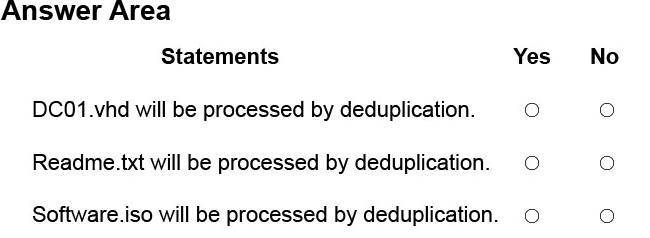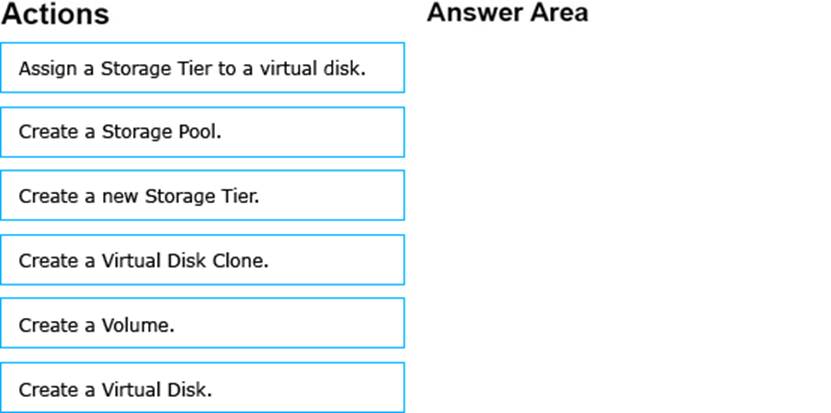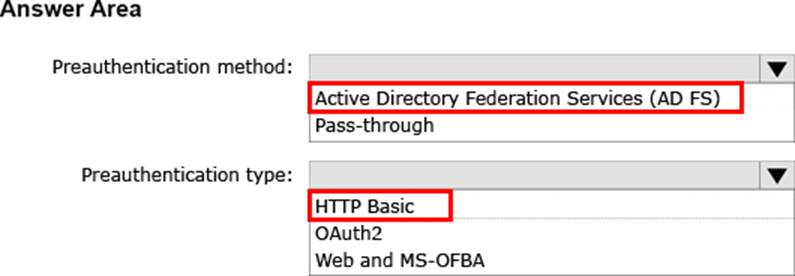Microsoft 70-743 Microsoft Upgrading Your Skills to MCSA: Windows Server 2016 Online Training
Microsoft 70-743 Online Training
The questions for 70-743 were last updated at Jan 21,2025.
- Exam Code: 70-743
- Exam Name: Microsoft Upgrading Your Skills to MCSA: Windows Server 2016
- Certification Provider: Microsoft
- Latest update: Jan 21,2025
Your network contains an Active Directory forest named contoso.com.
You have an Active Directory Federation Services (AD FS) farm. The farm contains a server named Server1 that runs Windows Server 2012 R2. You add a server named Server2 to the farm. Server2 runs Windows Server 2016.
You remove Server1 from the farm. You need to ensure that you can use role separation to manage the farm.
Which cmdlet should you run?
- A . Update-AdfsRelyingPartyTrust
- B . Invoke-AdfsFarmBehaviorLevelRaise
- C . Set-AdfsFarmInformation
- D . Set-AdfsProperties
HOTSPOT
You have a server named Server1 that runs Windows Server 2016. Server1 has the Web Application Proxy role service installed.
You need to publish Microsoft Exchange Server 2013 services through the Web Application Proxy. The solution must use preauthentication whenever possible.
How should you configure the preauthentication method for each service? To answer, select the appropriate options in the answer area.

HOTSPOT
You have a server named Server1 that runs Windows Server 2016. Server1 has the Windows Application Proxy role service installed.
You need to publish Microsoft Exchange ActiveSync services by using the Publish New Application Wizard. The ActiveSync services must use preauthentication.
How should you configure Server1? To answer, select the appropriate options in the answer area.

HOTSPOT
You have a server that runs Windows Server 2016.

For each of the following statements, select Yes if the statement is true. Otherwise, select No.

DRAG DROP
You have a server that runs Windows Server 2016. You install three additional disks named Disk1, Disk2, and Disk3. You plan to use these physical disks to store data.
You need to create a volume to store data. The solution must prevent data loss in the event of a single disk failure.
Which three actions should you perform in sequence? To answer, move the appropriate actions from the list of actions to the answer area and arrange them in the correct order.

Your network contains an Active Directory domain named contoso.com. The domain contains two servers named Server1 and Server2 that run Windows Server 2016. The servers have the same hardware configuration.
You need to asynchronously replicate volume F: from Server1 to Server2.
What should you do?
- A . Install the Failover Clustering feature and create a new cluster resource group.
- B . Run Set-DfsrServiceConfiguration and specify the CRPCPort parameter.
- C . Run New-SRPartnership and specify the CReplicationMode parameter.
- D . Install the Failover Clustering feature and use Cluster Shared Volumes (CSV).
You have a server named Server1 that runs Windows Server 2016.
The disks on Server1 are configured as shown in the following table:

Windows Server 2016 is installed in C:Windows.
On which two volumes can you enable data deduplication? Each correct answer presents a complete solution.
- A . C:
- B . D:
- C . E:
- D . F:
- E . G:
Note: This question is part of a series of questions that use the same or similar answer choices. An answer choice may be correct for more than one question in the series. Each question is independent of the other questions in this series. Information and details provided in a question apply only to that question.
You have a Hyper-V host named Server1 that runs Windows Server 2016. You plan to deploy several shielded virtual machines on Server1.
You deploy a Host Guardian on a new server.
You need to ensure that Server1 can host shielded virtual machines.
What should you do first?
- A . the Mount-VHD cmdlet
- B . the Diskpart command
- C . the Set-VHD cmdlet
- D . the Set-VM cmdlet
- E . the Set-VMHost cmdlet
- F . the Set-VMProcessor cmdlet
- G . the Install-WindowsFeature cmdlet
- H . the Optimize-VHD cmdlet
Note: This question is part of a series of questions that use the same or similar answer choices. An answer choice may be correct for more than one question in the series. Each question is independent of the other questions in this series. Information and details provided in a question apply only to that question.
You have an Active Directory domain that contains two Hyper-V servers named Server1 and Server2. Server1 has Windows Server 2016 installed. Server2 has Windows Server 2012 R2 installed.
Each Hyper-V server has three network cards. Each network card is connected to a different subnet. Server1 contains a dedicated migration network.
Server2 contains a virtual machine named VM5.
You plan to perform a live migration of VM5 to Server1.
You need to ensure that Server1 uses all available networks to perform the live migration of VM5.
What should you run?
- A . the Mount-VHD cmdlet
- B . the Diskpart command
- C . the Set-VHD cmdlet
- D . the Set-VM cmdlet
- E . the Set-VMHost cmdlet
- F . the Set-VMProcessorcmdlet
- G . the Install-WindowsFeature cmdlet
- H . the Optimize-VHD cmdlet
Note: This question is part of a series of questions that use the same or similar answer choices. An answer choice may be correct for more than one question in the series. Each question is independent of the other questions in this series. Information and details provided in a question apply only to that question.
You have a Hyper-V host named Server1 that runs Windows Server 2016. Server1 has a virtual machine that uses a virtual hard disk (VHD) named disk1.vhdx.
You receive the following warning message from Event Viewer: “One or more virtual hard disks have a physical sector size that is smaller than the physical sector size of the storage on which the virtual hard disk file is located.”
You need to resolve the problem that causes the warning message.
What should you run?
- A . the Mount-VHD cmdlet
- B . the Diskpart command
- C . the Set-VHD cmdlet
- D . the Set-VM cmdlet
- E . the Set-VMHost cmdlet
- F . the Set-VMProcessor cmdlet
- G . the Install-WindowsFeature cmdlet
- H . the Optimize-VHD cmdlet
Latest 70-743 Dumps Valid Version with 252 Q&As
Latest And Valid Q&A | Instant Download | Once Fail, Full Refund









